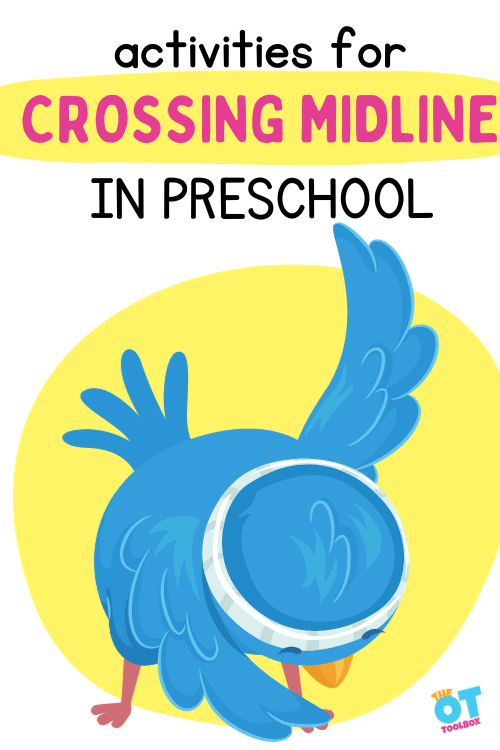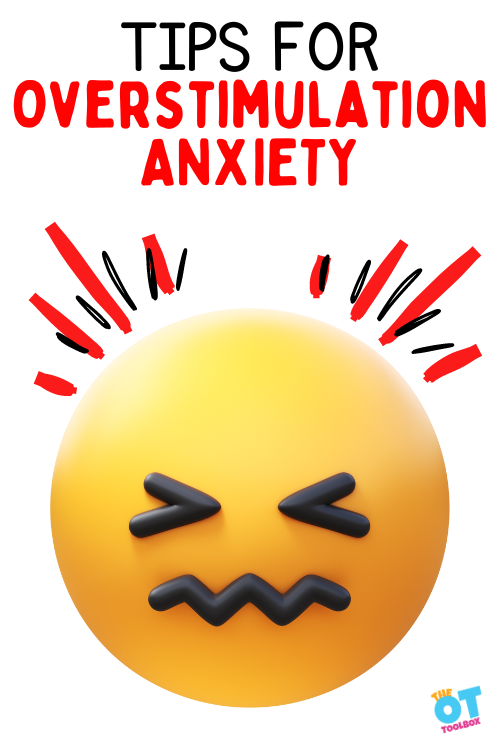Today’s article on Crossing the Midline Activities for Preschoolers will be full of ideas to practice and strengthen crossing the midline. Hopefully you caught the earlier post on the midline. It highlighted what crossing the midline is, how to identify deficits, and strengthen this important skill.

Why are we highlighting crossing the midline for preschoolers?
Why this subgroup specifically, since crossing the midline is an important skill for all learners? Preschool age of three to five is a critical area for development.
The baby years are spent exploring and learning basic developmental skills. Preschool age is important for practicing, learning, and refining skills.
Skills learned from ages three to five will become the building blocks for higher level cognitive and functional skills including fine motor, self-help, handwriting, gross motor, and adaptive skills.
A child who is missing the building blocks will have difficulty moving to the next level.
Imagine a student who does not know their numbers or addition, being asked to learn multiplication. They do not have the basic skills to learn and incorporate this higher-level skill. Writing begins with preschool prewriting strokes, then moves to letter formation. Many skills we learn are progressive. You would not try building a big house without a solid foundation.
Crossing the midline is no exception. A child who can not cross the midline will struggle with handwriting, reading, sports, self help skills, and more. There is a reason for the push toward early intervention for children. Build these skills early, then students can move forward with a solid foundation.
crossing the midline and the Brain
Let us do a quick recap of crossing the midline in case you missed the earlier post.
Crossing the midline is like drawing a line down the middle of your body. Many websites refer to this as reaching across the body with your arms and legs. Do not forget your eyes! Your eyes cross the midline as well, making reading, scanning, and writing possible.
From a scientific point of view, crossing the midline strengthens the neural connection between the left and right hemispheres of your brain (aka bilateral integration).
Crossing midline strengthens the neural connection between the left and right hemispheres of your brain (aka bilateral integration). The left brain has different functions than the right, but they need to be in constant communication to make things happen smoothly.
difficulty crossing the midline
There are some early warning signs we might see in the preschooler who struggles with crossing their midline. This should be a natural and efficient motor plan by the preschool years. When we see a difficulty with the integrated motor patterns, this can be an indicator for various challenges.
Some of the ways that difficulties with preschool crossing midline will present as:
- Not developing a dominant hand. Students use the left hand for left sided tasks and the right side for right sided tasks.
- Showing delays in crawling, or an atypical crawling pattern. Here is a great article on Cross Crawling Activities.
- Rotating or turning their entire body to retrieve objects on the other side of their body instead of reaching across the body to the other side
- Having difficulty with age-appropriate self-care tasks like dressing or grooming activities
- Skipping or doing jumping jacks in an uncoordinated manner. Check out this post on Gross Motor Midline Crossing Exercises
- Difficulty making a horizontal line across a piece of paper (may stop in the middle and switch hands, or pause visually) or forming letters
- Visual perceptual difficulties
- Delayed or below average reading skills due to difficulty reading smoothly across the paper
Crossing Midline Activities for Preschoolers
Play is the occupation of a child. Caregivers will have better success by making lessons fun. Adults barely tolerate physical exercises like lunges and squats, what makes us think preschoolers will?
Turning skill acquisition into a fun game is a surefire way to engage your preschoolers.
Here is a great post on Occupational Therapy Activities for Preschoolers, and another one on Preschool Activities.
Start by checking out the list of activities and make a note what skills they are targeting. I bet there are some on there addressing crossing the midline.
Below are specific activities to target crossing midline for preschool aged children.
Midline Activities for Preschoolers
Let us look specifically at crossing midline activities for preschoolers. These activities will work for older children but for the purpose of this article we are highlighting ones for the three- to five-year-old crowd.
- Cross midline by reaching for stickers– Place stickers on your child’s clothing in different locations. Encourage them to reach across midline to pull them off and stick them onto a paper or board. Here are more benefits of playing with stickers.
2. Encourage midline crossing with clothes pins- Similar to the stickers grab, clip clothespins to your child’s clothing, having them retrieve them. Purposefully pick places they can not reach with the hand on the same side such as the top of the shoulder or elbow. Here are various clothes pin activities that can be used to target midline crossing skills.
3. Sorting activities- have students sort items into different containers using one hand only. You can switch sides half way through, but encourage use of just one side at a time. Start with sorting colors activities and move to other areas such as sorting letters by size or sorting shapes.
4. Midline Crossing with Preschool Chores– While chores are work for adults, they are often novel for young children. Sweeping, using a duster, pushing a vacuum, wiping down tables, and washing the car, all involve reaching across the body. You can use a visual reward schedule along with chores for preschoolers…and add those stickers from point number 1 listed above.
5. Yoga for kids- There are some great yoga poses that involve crossing the midline. Use our unicorn yoga activities, penguin yoga activities, or even partner yoga poses to target midline crossing.
6. Playing with trains, cars, or other vehicles- One way to work on midline crossing with preschoolers is by zooming cars down a track or trains around their track. Especially when playing on a floor with cars, this helps encourage crossing midline but also developing core strength and stability which is necessary for mobility needed for midline crossing skills.
7. Simon says- While younger children might not understand the exact rules of this game, they can work on imitating and following directions. Add Simon Says directions like: touch your opposite shoulder, do jumping jacks, side strides, clapping movements, etc. Our list of Simon Says commands has many gross motor tasks that encourage midline crossing for preschoolers.
8. Rubbing lotion on the arms or legs- You can target midline crossing with preschoolers using a functional task: applying lotion! Ask children to rub in lotion by strategically add lotion to parts of the body only reachable by crossing over the midline. This can be extended to rubbing in sunscreen too.
9. Rainbow draw- We shared our crossing the midline rainbow activity before as a tool to target visual scanning skills. Have your student sit on a large piece of paper or stand at a chalkboard/dry erase board. Using one hand only, have them draw a rainbow across their body with different colors.
More crossing midline activities for preschoolers
- Ball pass- Your child is seated on the floor with a bucket of bean bags or other items on each side. They need to move the bean bags to the opposite side across their body.
- Obstacle courses – Create obstacle courses that involve jumping, crawling, marching
- Scooter and plunger- The students sit on a scooter and “paddle” forward with a plunger.
- Swing a baseball bat- Hang a wiffle ball from a string and have your child hold the bat with two hands to try and hit the ball.
- Painting on an easel- Use large paper on an easel or other vertical surface. Large paper calls for large movements. Be mindful that your child is using one hand for this task
- Arm isolation- Play a game where your child has one arm hidden in a sleeve or is wearing a sock over their non dominant hand if they need their arm for safety. Have them work on different table top tasks without being able to use both hands.
- Animal walks- Taking brain breaks to practice crab crawl or bear walk has multiple benefits at once.
- Twister- This popular game can be modified for the preschool age population
- Visual scanning- Scatter lots of items on a large table. Have students visually scan looking for something. There are lots of printables for visual scanning available. Check out this OT Toolbox search for scanning activities
- Hand clapping games – These are especially helpful when clapping with a partner, having to touch opposite hands or legs
- Prone reaching- Kids can lie prone over a large ball while reaching for items in different locations
- Bilateral tasks- bilateral coordination activities work on crossing midline as each side of the body is responsible for doing something different. Stringing beads, reading a book, coloring, cutting with scissors, puzzles, etc.
- Magnadoodle- This simple toy is not only great for developing fine motor skills, but erasing in involves sliding the eraser across the doodler.
- Cooking- There are many aspects of cooking with kids that foster midline crossing. What about stirring, spreading, pouring, measuring, and scooping?
- Back to back ball pass- Sit back to back with your child, pass a ball back and forth by twisting your body to reach the other person.
A final thought on crossing midline in Preschool
As you read through these activities you may find you have already been doing many of them. Perhaps you are already an expert and just needed confirmation that you are on the right track.
Maybe you are new to this and felt overwhelmed seeing a “crossing midline” goal on a plan of care.
Having therapy students keeps me on my toes because they have to break down tasks and do activity analysis all the time. I have been put on the spot many times when asked what therapeutic intervention or model I am following. I say, “I don’t know, play?”

Victoria Wood, OTR/L is a contributor to The OT Toolbox and has been providing Occupational Therapy treatment in pediatrics for more than 25 years. She has practiced in hospital settings (inpatient, outpatient, NICU, PICU), school systems, and outpatient clinics in several states. She has treated hundreds of children with various sensory processing dysfunction in the areas of behavior, gross/fine motor skills, social skills and self-care. Ms. Wood has also been a featured speaker at seminars, webinars, and school staff development training. She is the author of Seeing your Home and Community with Sensory Eyes.


